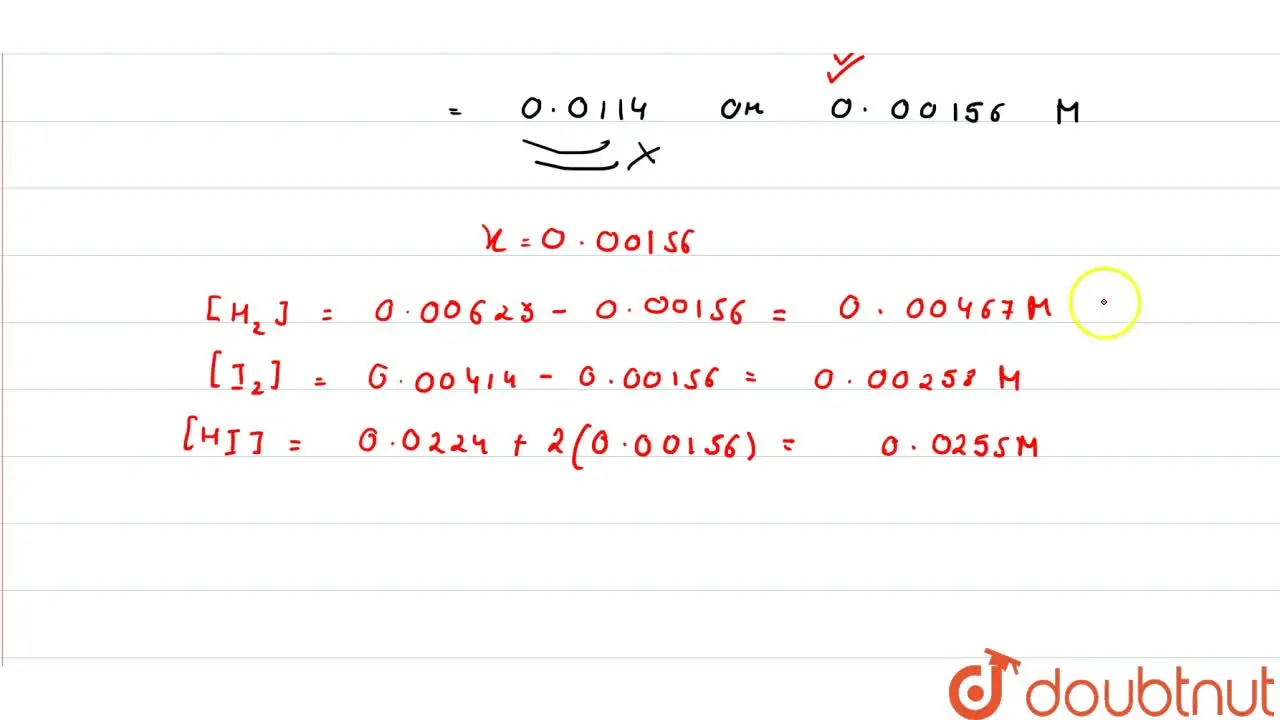The equilibrium constant for the reaction is at . If the initial concentrations of , and are , , and , respectively, calculate the concentrations of these species at equilibrium.
The only difference is that now we have non-stoichiometric amounts of reactants. Also, find the value of to decide the direction of reaction.
Solution: Let x be the decrease in concentration for and at equilibrium. Then, according to the stoichiometry of the reaction, the increase in concentration for must be . Summarize the changes n concentrations as follows:
Note that we have considered the net reaction in the forward direction because is less than .
Step 2: Writing the equilibrium constant expression
Substituting, we get
It is not possible to solve this equation by the square root shortcut as the left side of this equation is not a perfect square, because the starting concentrations of and are unequal. Instead, we can arrange this quardratic equation into the standard form by carrying out the multiplications:
Collecting terms, we get
This is a quardratic equation of the form , which can be solved by the quardratic formula
In this case, we have
, and
Substituting these values gives
or
The first solution is physically impossible since the amounts of and reacted would be more than those originally present. The second solution gives the correct answer. Note that in solving a quardratic equation of this type, one answer is always physically impossible. Thus, the choice of which value to use for x is easy to make.
Step 3: The equilibrium concentrations are
Related Playlists
- BOOK - R SHARMACHAPTER - EQUILIBRIUMEXERCISE - Follow-up Test 110videos
EQUILIBRIUM
- BOOK - R SHARMACHAPTER - EQUILIBRIUMEXERCISE - Follow-up Test 27videos
EQUILIBRIUM
- BOOK - R SHARMACHAPTER - CLASSIFICATION OF ELEMENTS AND PERIODICITY IN ELEMENTSEXERCISE - ARCHIVES37videos
CLASSIFICATION OF ELEMENTS AND PERIODICITY IN ELEMENTS
- BOOK - R SHARMACHAPTER - GENERAL ORGANIC CHEMISTRYEXERCISE - Archives36videos
GENERAL ORGANIC CHEMISTRY
Similar Questions
The equilibrium constant Kp for the reaction H2(g)+I2(g)⇔2HI(g) changes if:
View SolutionThe equilibrium constant for the reaction H2(g)+I2(g)⇔2HI(g) is 32 at a given temperature. The equilibrium concentration of I2 and HI are 0.5×10−3 and 8×10−3M respectively. The equilibrium concentration of H2 is
View SolutionThe equilibrium constant Kp for the reaction H2(g)+I2(g)⇔2HI(g) changes if:
View SolutionFor the reaction H2(g)+I2(g)⇔2HI(g), the equilibrium constant Kp Changes with
View SolutionThe equilibrium constant for the reaction,
H2(g)+I2(g)⇔2HI(g)
is 16 at 600 K . What will be the concentration of H2,I2 and HI if two moles of hydrogen and three moles of iodine are injected into a litre flask .View SolutionFor the reaction H2(g)+I2(g)⇔2HI(g), the equilibrium constant will change with
View SolutionFor the reaction H2(g)+I2(g)⇔2HI(g)
the equilibrium constant Kp changes withView SolutionFor the reaction
H2(g)+I2(g)⇔2HI(g)
The equilibrium constant Kp changes withView SolutionIf the equilibrium constant of the reaction 2HI(g)⇔H2(g)+I2(g) is 0.25, the equilibrium constant of the reaction
12H2(g)+12I2(g)⇔HI(g)
will beView SolutionEquilibrium constant for the reaction:
H2(g)+I2(g)⇔2HI(g)isKc=50at25∘C
The standard Gibbs free enegry change for the reaction will be:View Solution


